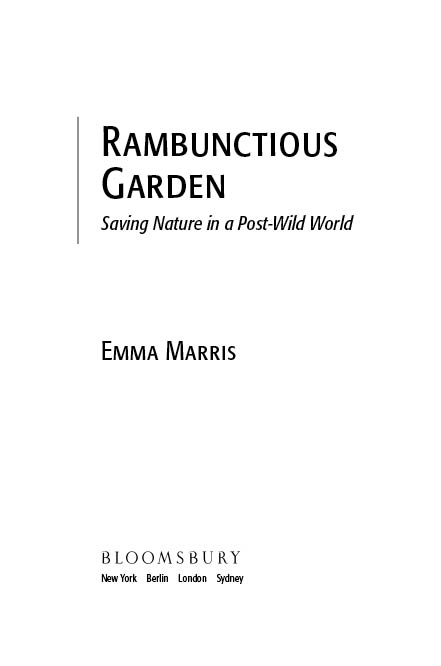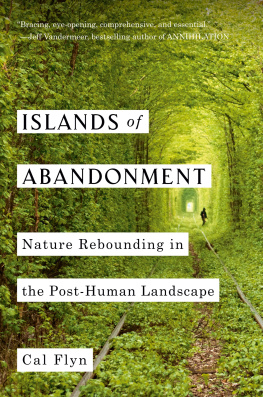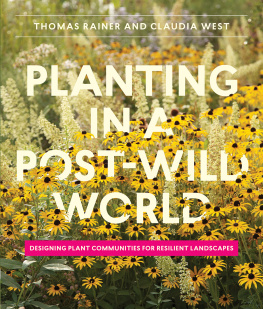
Copyright 2011 by Emma Maris
Published by Bloomsbury USA, New York
LIBRARY OF CONGRESS CATALOGING-IN-PUBLICATION DATA HAS BEEN APPLIED FOR.
ISBN 978-1-60819-032-4 (hardback)
First published by Bloomsbury USA in 2011
This e-book edition published in 2011
Electronic edition published in 2011
E-book ISBN: 978-1-60819-455-1 (ebook)
All rights reserved. No part of this book may be reproduced or transmitted in any form or by any means, electronic or mechanical, including photocopying, recording, or by any information storage and retrieval system, without permission in writing from the publisher.
www.bloomsburyusa.com
To my mother, Kathrine Beck, for sending me to Audubon Day Camp.
C ONTENTS
We have lost a lot of nature in the past three hundred yearsin both senses of the word lost. We have lost nature in the sense that much nature has been destroyed: where there was a tree, there is a house; where there was a creek, there is a pipe and a parking lot; where there were passenger pigeons and Stellers sea cows, there are now skins and bones in dimly lit museum galleries. But we have also lost nature in another sense. We have misplaced it. We have hidden nature from ourselves.
Our mistake has been thinking that nature is something out there, far away. We watch it on TV, we read about it in glossy magazines. We imagine a place, somewhere distant, wild and free, a place with no people and no roads and no fences and no power lines, untouched by humanitys great grubby hands, unchanging except for the seasons turn. This dream of pristine wilderness haunts us. It blinds us.
Many ecologists spend their lives studying the most pristine places they can find, and many conservationists spend their lives desperately trying to stop wilderness from changing. We cling to fragments of virgin or old growth forests, to the last great places, the ever-rarer intact ecosystems, but they slip through our fingers. Like slivers of soap, they shrink and disappear. And we mourn. We are always mourning, because we cant make more of such places. Every year there are fewer of them than the year before.
This book is about a new way of seeing nature. Yes, nature is carefully managed national parks and vast boreal forest and uninhabited arctic. Nature is also the birds in your backyard; the bees whizzing down Fifth Avenue in Manhattan; the pines in rows in forest plantations; the blackberries and butterfly bushes that grow alongside the urban river; the Chinese tree-of-heaven or ghetto palm growing behind the corner store; the quail strutting through the farmers field; the old field overgrown with weeds and shrubs and snakes and burrowing mammals; the jungle thick with plants labeled invasive pests; the carefully designed landscape garden; the green roof; the highway median; the five-hundred-year-old orchard folded into the heart of the Amazon; the avocado tree that sprouts in your compost pile.
Nature is almost everywhere. But wherever it is, there is one thing that nature is not: pristine. In 2011 there is no pristine wilderness on planet Earth. Weve been changing the landscapes we inhabit for millennia, and these days our reach is truly global. Inhale. That breath has 36 percent more molecules of carbon dioxide than it would have had in 1750. songbirds giving full throat to complex car alarm sequences. But more significant are global phenomena like climate change, species movements, and large-scale transformations of land.
We are already running the whole Earth, whether we admit it or not. To run it consciously and effectively, we must admit our role and even embrace it. We must temper our romantic notion of untrammeled wilderness and find room next to it for the more nuanced notion of a global, half-wild rambunctious garden, tended by us.
This garden isnt restricted to parks and protected areas. The rambunctious garden is everywhere. Conservation can happen in parks, on farms, in the strips of land attached to rest stops and fast-food joints, in your backyard, on your roof, even in city traffic circles. Rambunctious gardening is proactive and optimistic; it creates more and more nature as it goes, rather than just building walls around the nature we have left.
Many conservationists are opening up their definitions of nature and embracing a whole suite of possible goals beyond the familiar pristine wilderness goal. They find that when they do, they can use all sorts of new tools and approaches, the stories of which will be told in the chapters to come. As they experiment, they are finding that the values that got them into conservation in the first place are still relevant. We can cherish evolution in action even if all the species struggling for existence arent native. We can protect ecological processes like soil formation and water filtration that benefit us. We can marvel at the diversity of life and fight its disappearance, even if that diversity occurs in unfamiliar places. We can find beauty in nature, even if signs of humanity are present. We can see the sublime in our own backyards, if we try.
But changing our ideas about nature isnt easy. Its hard for you and me; its probably hardest for those who have spent their lives studying and protecting wilderness. The scientists who are trained to be dispassionate are often the most passionate and opinionated when it comes to what counts as nature and what is worth saving.
Even those who are interested in expanding their conception of nature run into problems. The notion of a stable, pristine wilderness as the ideal for every landscape is woven into the culture of ecology and conservationespecially in the United States. Take the baseline . Virtually every scientific study of environmental change uses or assumes a baseline. Baselines are reference states, typically a time in the past or a set of conditions, a zero point before all negative changes. In the past, a places default baseline was often before Europeans arrived. Today, as we learn more about how indigenous inhabitants of places from Australia to the Americas changed their surroundings, it is sometimes set to before any humans arrived. For many conservationists, restoration to a prehuman or pre-European baseline is seen as healing a wounded or sick nature. For others, it is an ethical duty. We broke it; therefore we must fix it. Baselines thus typically dont just act as a scientific before to compare with an after. They become the good , the goal, the one correct state.
When conservationists restore a site or manage a park this way, they first set a baseline. Then they characterize the site at that time. What species existed then, in what proportion? Where were the rivers? How deep and wide were they, and how fast did they flow? Where was the shoreline? What properties did the soil have? Once they have picked a baseline and characterized it, they have to get down to the heavy lifting of wrestling the area backward in time. Some species are removed, others reintroduced. Rivers are engineered, islands are built of sand, trees are killed and left to provide rotting habitat for beetles, and so on.
But ecosystems are slippery, and setting a baseline is not straightforward. Take Hawaii, some of the remotest islands in the world, home to hundreds of species that live nowhere else, many of which are rare and at risk for extinction. Earlier ecologists might have used 1778, the year Captain James Cook landed in Hawaii, as the baseline date for the island chain. But restoring the islands ecosystems to the way they were in 1777 would be restoring them to a state very much shaped by the Polynesians who had been living there for at least one thousand years: a semidomesticated landscape filled with species the Polynesians brought with them, including taro, sugarcane, pigs, chickens, and rats, and missing others, including at least fifty species of birds, who were hunted out by the first arrivals.
Next page







